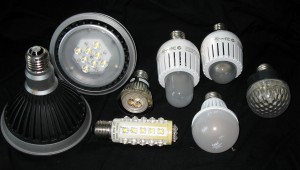Nowadays LED has become an inaccessible part of our life. Today, I will give you a brief introduction to the concept, characteristics, and classification.
The Concept of LED
An LED (Light Emitting Diode) is a solid-state semiconductor device that converts electricity directly to Light. The heart of the LED is a semiconductor chip, with one end attached to a scaffold, one end of which is a negative electrode, and the other end connected to the positive end of the power supply, so that the entire chip is enclosed in an epoxy resin.
A semiconductor chip is made up of two parts, one of which is a p-type semiconductor, in which holes dominate, and the other of which is an n-type semiconductor, on which electrons dominate. But when the two semiconductors are connected, a “p-n junction” forms between them. When a current is applied to the chip through the wire, the electrons are pushed to the p-region, where they reunite with the hole and emit energy in the form of photons, which is how LEDs glow. And the wavelength of the light, the color of the light, is determined by the material that forms the P-N junction.
The Characteristics of LED
The intrinsic characteristics of LED determine that it is the most ideal light source to replace the traditional light source, it has a wide range of applications.
- Small Volume
An LED is basically a very small chip encapsulated in an epoxy resin, so it’s very small and very light.
-Low Power Consumption
LED power consumption is very low, generally speaking, LED operating voltage is 2-3.6V.
The working current is 0.02-0.03A.
That is to say, it consumes no more than 0.1W of electricity.
- Long Service Life
With the right current and voltage, LEDs can have a service life of up to 100,000 hours.
- High Brightness and Low Heat
- Environmental Protection
LEDs are made of non-toxic materials, unlike fluorescent lamps, which contain mercury and cause pollution. They can also be recycled.
- Strong and Durable
LEDs are fully encapsulated in epoxy resin, which is stronger than both light bulbs and fluorescent tubes.There are also no loose parts inside the lamp, which makes the LEDs indestructible.
The Classification of LED
1, According to the light emitting tube color points
According to the light emitting color of the light emitting tube, it can be divided into red, orange, green (and yellow green, standard green and pure green), blue and so on.
In addition, some LEDs contain chips of two or three colors.
According to the light emitting diode mixed or not mixed with scatterers, colored or colorless, the above various colors of LED can also be divided into colored transparent, colorless transparent, colored scattering and colorless scattering of four types.
Scattering light-emitting diodes and light – emitting diodes can be used as indicator lamps.
2.According to the characteristics of the luminous surface of the light emitting tube
According to the characteristics of light emitting surface of light emitting tube, it can be divided into round lamp, square lamp, rectangular lamp, face light emitting tube, side tube and micro tube for surface installation, etc.
The circular lamp is divided into Φ2mm, Φ4.4mm, Φ5mm, Φ8mm, Φ10mm and Φ20mm, etc.
Foreign usually record the Φ3mm light-emitting diode as T-1, φ5mm as T-1 (3/4), and φ4.4mm as T-1 (1/4).
3.According to the structure of light-emitting diodes
According to the structure of LED, there are all epoxy encapsulation, metal base epoxy encapsulation, ceramic base epoxy encapsulation and glass encapsulation.
4.According to luminous intensity and working current
According to the luminous intensity and working current is divided into ordinary brightness LED (luminous intensity 100mCD);
The luminous intensity between 10 and 100mCD is called high brightness light-emitting diode.
The working current of general LED is from ten mA to dozens of mA, while the working current of low current LED is below 2mA (the brightness is the same as that of ordinary light-emitting tube).
In addition to the above classification methods, there are also classification methods by chip material and by function.
Ted: next article is also about LED. What is it? Please stay tuned. ![]()
Post time: Jan-27-2021
